Abstract
The high mortality from malaria in sub-Sahara Africa selected multiple genes that give the population a selective advantage. Identification of the genetic basis for resistance may suggest unusual approaches to development of malarial vaccines and antimalarial drugs. Some of these genes may be deleterious, although of selective advantage within the African setting, and need to be identified for counseling for disease prevention.
Full text
PDF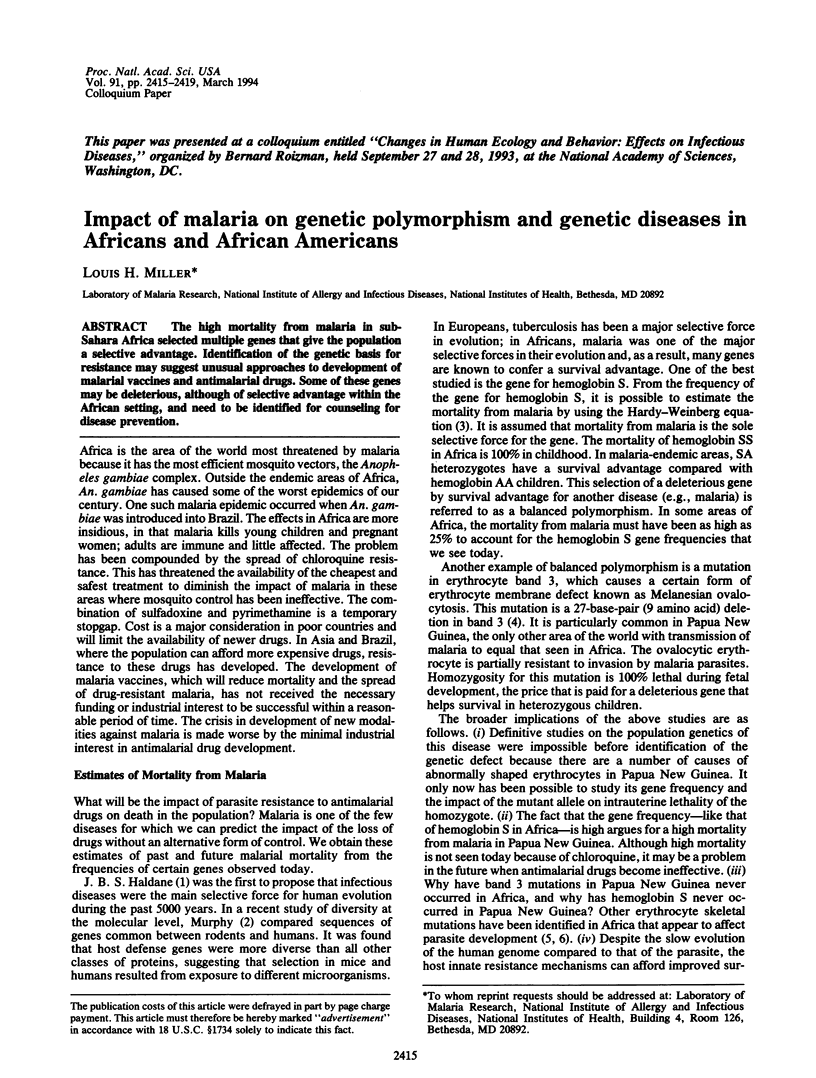
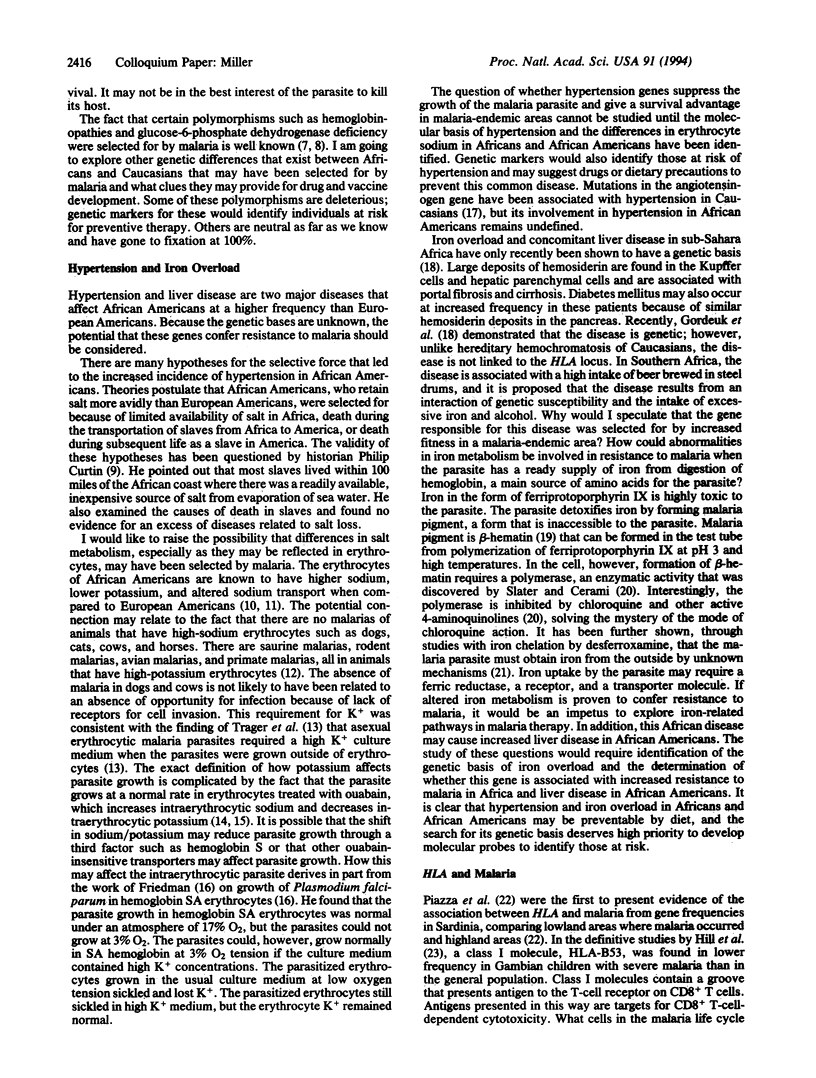
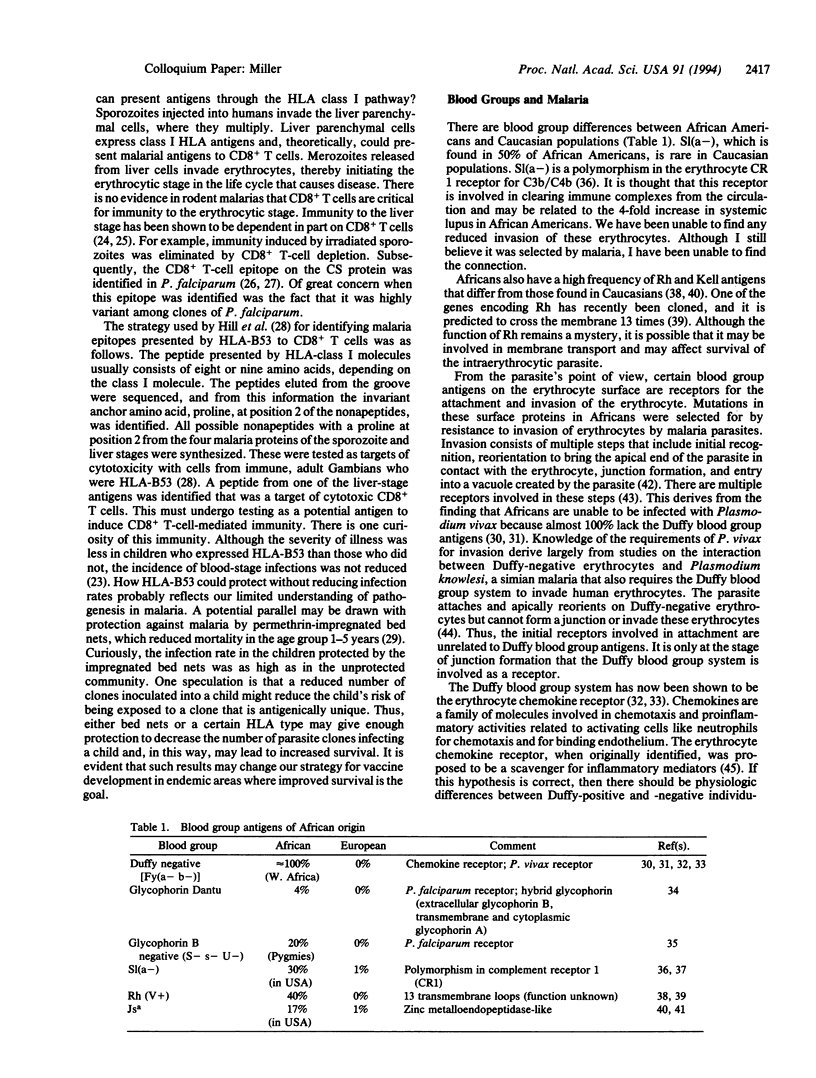
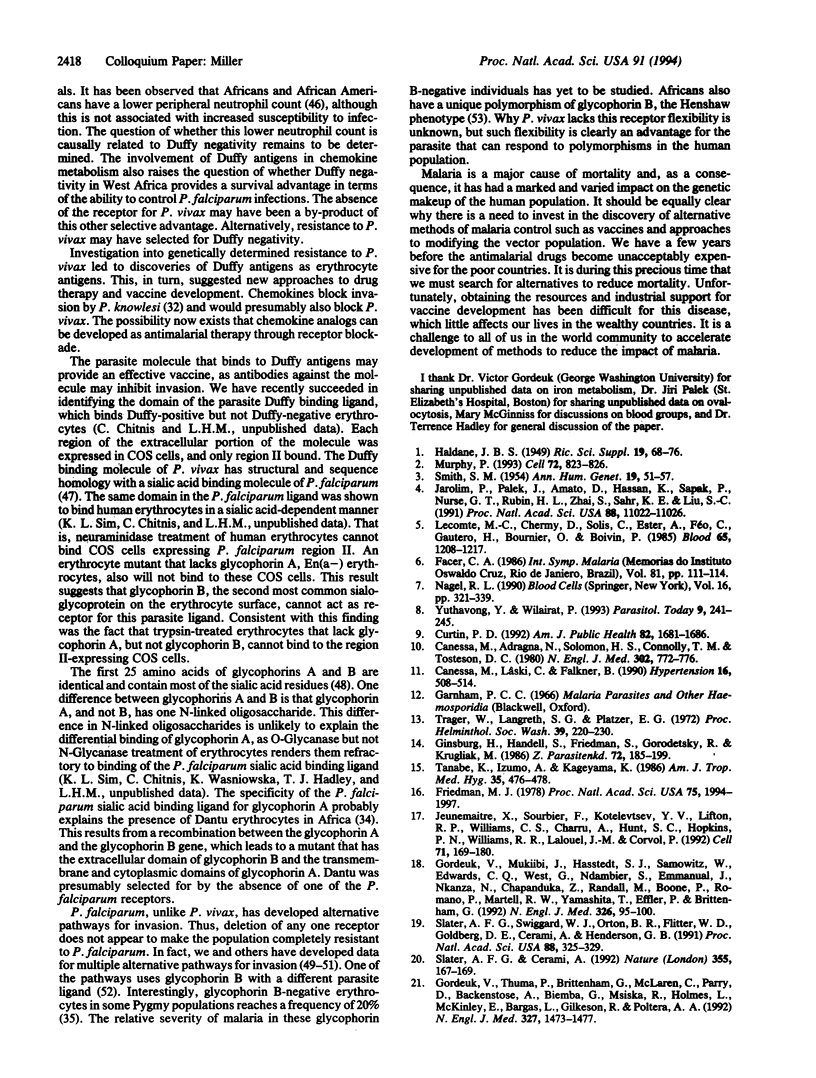
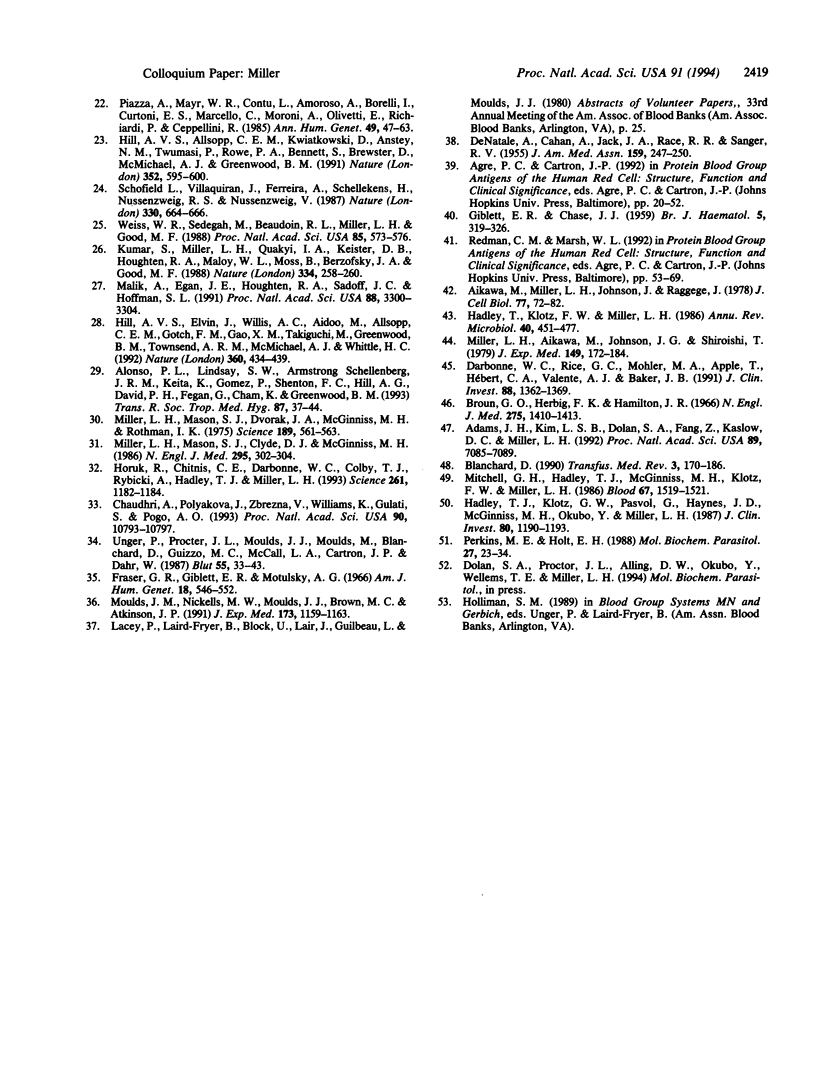
Selected References
These references are in PubMed. This may not be the complete list of references from this article.
- Adams J. H., Sim B. K., Dolan S. A., Fang X., Kaslow D. C., Miller L. H. A family of erythrocyte binding proteins of malaria parasites. Proc Natl Acad Sci U S A. 1992 Aug 1;89(15):7085–7089. doi: 10.1073/pnas.89.15.7085. [DOI] [PMC free article] [PubMed] [Google Scholar]
- Aikawa M., Miller L. H., Johnson J., Rabbege J. Erythrocyte entry by malarial parasites. A moving junction between erythrocyte and parasite. J Cell Biol. 1978 Apr;77(1):72–82. doi: 10.1083/jcb.77.1.72. [DOI] [PMC free article] [PubMed] [Google Scholar]
- Alonso P. L., Lindsay S. W., Armstrong Schellenberg J. R., Keita K., Gomez P., Shenton F. C., Hill A. G., David P. H., Fegan G., Cham K. A malaria control trial using insecticide-treated bed nets and targeted chemoprophylaxis in a rural area of The Gambia, west Africa. 6. The impact of the interventions on mortality and morbidity from malaria. Trans R Soc Trop Med Hyg. 1993 Jun;87 (Suppl 2):37–44. doi: 10.1016/0035-9203(93)90174-o. [DOI] [PubMed] [Google Scholar]
- Blanchard D. Human red cell glycophorins: biochemical and antigenic properties. Transfus Med Rev. 1990 Jul;4(3):170–186. doi: 10.1016/s0887-7963(90)70263-5. [DOI] [PubMed] [Google Scholar]
- Broun G. O., Jr, Herbig F. K., Hamilton J. R. Leukopenia in Negroes. N Engl J Med. 1966 Dec 22;275(25):1410–1413. doi: 10.1056/NEJM196612222752504. [DOI] [PubMed] [Google Scholar]
- Canessa M., Adragna N., Solomon H. S., Connolly T. M., Tosteson D. C. Increased sodium-lithium countertransport in red cells of patients with essential hypertension. N Engl J Med. 1980 Apr 3;302(14):772–776. doi: 10.1056/NEJM198004033021403. [DOI] [PubMed] [Google Scholar]
- Canessa M., Laski C., Falkner B. Red blood cell Na+ transport as a predictor of blood pressure response to Na+ load in young blacks and whites. Hypertension. 1990 Nov;16(5):508–514. doi: 10.1161/01.hyp.16.5.508. [DOI] [PubMed] [Google Scholar]
- Chaudhuri A., Polyakova J., Zbrzezna V., Williams K., Gulati S., Pogo A. O. Cloning of glycoprotein D cDNA, which encodes the major subunit of the Duffy blood group system and the receptor for the Plasmodium vivax malaria parasite. Proc Natl Acad Sci U S A. 1993 Nov 15;90(22):10793–10797. doi: 10.1073/pnas.90.22.10793. [DOI] [PMC free article] [PubMed] [Google Scholar]
- Curtin P. D. The slavery hypothesis for hypertension among African Americans: the historical evidence. Am J Public Health. 1992 Dec;82(12):1681–1686. doi: 10.2105/ajph.82.12.1681. [DOI] [PMC free article] [PubMed] [Google Scholar]
- DENATALE A., CAHAN A., JACK J. A., RACE R. R., SANGER R. V, a new Rh antigen, common in Negroes, rare in white people. J Am Med Assoc. 1955 Sep 24;159(4):247–250. [PubMed] [Google Scholar]
- Darbonne W. C., Rice G. C., Mohler M. A., Apple T., Hébert C. A., Valente A. J., Baker J. B. Red blood cells are a sink for interleukin 8, a leukocyte chemotaxin. J Clin Invest. 1991 Oct;88(4):1362–1369. doi: 10.1172/JCI115442. [DOI] [PMC free article] [PubMed] [Google Scholar]
- Fraser G. R., Giblett E. R., Motulsky A. G. Population genetic studies in the Congo. 3. Blood groups (ABO, MNSs, Rh, Jsa). Am J Hum Genet. 1966 Nov;18(6):546–552. [PMC free article] [PubMed] [Google Scholar]
- Friedman M. J. Erythrocytic mechanism of sickle cell resistance to malaria. Proc Natl Acad Sci U S A. 1978 Apr;75(4):1994–1997. doi: 10.1073/pnas.75.4.1994. [DOI] [PMC free article] [PubMed] [Google Scholar]
- GIBLETT E. R., CHASE J. Jsa, a 'new' red-cell antigen found in Negroes: evidence for an eleventh blood group system. Br J Haematol. 1959 Jul;5:319–326. doi: 10.1111/j.1365-2141.1959.tb04040.x. [DOI] [PubMed] [Google Scholar]
- Ginsburg H., Handeli S., Friedman S., Gorodetsky R., Krugliak M. Effects of red blood cell potassium and hypertonicity on the growth of Plasmodium falciparum in culture. Z Parasitenkd. 1986;72(2):185–199. doi: 10.1007/BF00931146. [DOI] [PubMed] [Google Scholar]
- Gordeuk V., Mukiibi J., Hasstedt S. J., Samowitz W., Edwards C. Q., West G., Ndambire S., Emmanual J., Nkanza N., Chapanduka Z. Iron overload in Africa. Interaction between a gene and dietary iron content. N Engl J Med. 1992 Jan 9;326(2):95–100. doi: 10.1056/NEJM199201093260204. [DOI] [PubMed] [Google Scholar]
- Gordeuk V., Thuma P., Brittenham G., McLaren C., Parry D., Backenstose A., Biemba G., Msiska R., Holmes L., McKinley E. Effect of iron chelation therapy on recovery from deep coma in children with cerebral malaria. N Engl J Med. 1992 Nov 19;327(21):1473–1477. doi: 10.1056/NEJM199211193272101. [DOI] [PubMed] [Google Scholar]
- Hadley T. J. Invasion of erythrocytes by malaria parasites: a cellular and molecular overview. Annu Rev Microbiol. 1986;40:451–477. doi: 10.1146/annurev.mi.40.100186.002315. [DOI] [PubMed] [Google Scholar]
- Hadley T. J., Klotz F. W., Pasvol G., Haynes J. D., McGinniss M. H., Okubo Y., Miller L. H. Falciparum malaria parasites invade erythrocytes that lack glycophorin A and B (MkMk). Strain differences indicate receptor heterogeneity and two pathways for invasion. J Clin Invest. 1987 Oct;80(4):1190–1193. doi: 10.1172/JCI113178. [DOI] [PMC free article] [PubMed] [Google Scholar]
- Hill A. V., Allsopp C. E., Kwiatkowski D., Anstey N. M., Twumasi P., Rowe P. A., Bennett S., Brewster D., McMichael A. J., Greenwood B. M. Common west African HLA antigens are associated with protection from severe malaria. Nature. 1991 Aug 15;352(6336):595–600. doi: 10.1038/352595a0. [DOI] [PubMed] [Google Scholar]
- Hill A. V., Elvin J., Willis A. C., Aidoo M., Allsopp C. E., Gotch F. M., Gao X. M., Takiguchi M., Greenwood B. M., Townsend A. R. Molecular analysis of the association of HLA-B53 and resistance to severe malaria. Nature. 1992 Dec 3;360(6403):434–439. doi: 10.1038/360434a0. [DOI] [PubMed] [Google Scholar]
- Horuk R., Chitnis C. E., Darbonne W. C., Colby T. J., Rybicki A., Hadley T. J., Miller L. H. A receptor for the malarial parasite Plasmodium vivax: the erythrocyte chemokine receptor. Science. 1993 Aug 27;261(5125):1182–1184. doi: 10.1126/science.7689250. [DOI] [PubMed] [Google Scholar]
- Jarolim P., Palek J., Amato D., Hassan K., Sapak P., Nurse G. T., Rubin H. L., Zhai S., Sahr K. E., Liu S. C. Deletion in erythrocyte band 3 gene in malaria-resistant Southeast Asian ovalocytosis. Proc Natl Acad Sci U S A. 1991 Dec 15;88(24):11022–11026. doi: 10.1073/pnas.88.24.11022. [DOI] [PMC free article] [PubMed] [Google Scholar]
- Jeunemaitre X., Soubrier F., Kotelevtsev Y. V., Lifton R. P., Williams C. S., Charru A., Hunt S. C., Hopkins P. N., Williams R. R., Lalouel J. M. Molecular basis of human hypertension: role of angiotensinogen. Cell. 1992 Oct 2;71(1):169–180. doi: 10.1016/0092-8674(92)90275-h. [DOI] [PubMed] [Google Scholar]
- Kumar S., Miller L. H., Quakyi I. A., Keister D. B., Houghten R. A., Maloy W. L., Moss B., Berzofsky J. A., Good M. F. Cytotoxic T cells specific for the circumsporozoite protein of Plasmodium falciparum. Nature. 1988 Jul 21;334(6179):258–260. doi: 10.1038/334258a0. [DOI] [PubMed] [Google Scholar]
- Lecomte M. C., Dhermy D., Solis C., Ester A., Féo C., Gautero H., Bournier O., Boivin P. A new abnormal variant of spectrin in black patients with hereditary elliptocytosis. Blood. 1985 May;65(5):1208–1217. [PubMed] [Google Scholar]
- Malik A., Egan J. E., Houghten R. A., Sadoff J. C., Hoffman S. L. Human cytotoxic T lymphocytes against the Plasmodium falciparum circumsporozoite protein. Proc Natl Acad Sci U S A. 1991 Apr 15;88(8):3300–3304. doi: 10.1073/pnas.88.8.3300. [DOI] [PMC free article] [PubMed] [Google Scholar]
- Miller L. H., Aikawa M., Johnson J. G., Shiroishi T. Interaction between cytochalasin B-treated malarial parasites and erythrocytes. Attachment and junction formation. J Exp Med. 1979 Jan 1;149(1):172–184. doi: 10.1084/jem.149.1.172. [DOI] [PMC free article] [PubMed] [Google Scholar]
- Miller L. H., Mason S. J., Clyde D. F., McGinniss M. H. The resistance factor to Plasmodium vivax in blacks. The Duffy-blood-group genotype, FyFy. N Engl J Med. 1976 Aug 5;295(6):302–304. doi: 10.1056/NEJM197608052950602. [DOI] [PubMed] [Google Scholar]
- Miller L. H., Mason S. J., Dvorak J. A., McGinniss M. H., Rothman I. K. Erythrocyte receptors for (Plasmodium knowlesi) malaria: Duffy blood group determinants. Science. 1975 Aug 15;189(4202):561–563. doi: 10.1126/science.1145213. [DOI] [PubMed] [Google Scholar]
- Mitchell G. H., Hadley T. J., McGinniss M. H., Klotz F. W., Miller L. H. Invasion of erythrocytes by Plasmodium falciparum malaria parasites: evidence for receptor heterogeneity and two receptors. Blood. 1986 May;67(5):1519–1521. [PubMed] [Google Scholar]
- Moulds J. M., Nickells M. W., Moulds J. J., Brown M. C., Atkinson J. P. The C3b/C4b receptor is recognized by the Knops, McCoy, Swain-langley, and York blood group antisera. J Exp Med. 1991 May 1;173(5):1159–1163. doi: 10.1084/jem.173.5.1159. [DOI] [PMC free article] [PubMed] [Google Scholar]
- Murphy P. M. Molecular mimicry and the generation of host defense protein diversity. Cell. 1993 Mar 26;72(6):823–826. doi: 10.1016/0092-8674(93)90571-7. [DOI] [PubMed] [Google Scholar]
- Perkins M. E., Holt E. H. Erythrocyte receptor recognition varies in Plasmodium falciparum isolates. Mol Biochem Parasitol. 1988 Jan 1;27(1):23–34. doi: 10.1016/0166-6851(88)90021-7. [DOI] [PubMed] [Google Scholar]
- Piazza A., Mayr W. R., Contu L., Amoroso A., Borelli I., Curtoni E. S., Marcello C., Moroni A., Olivetti E., Richiardi P. Genetic and population structure of four Sardinian villages. Ann Hum Genet. 1985 Jan;49(Pt 1):47–63. doi: 10.1111/j.1469-1809.1985.tb01675.x. [DOI] [PubMed] [Google Scholar]
- SMITH S. M. Appendix to notes on sicklecell polymorphism. Ann Hum Genet. 1954 Jul;19(1):51–57. doi: 10.1111/j.1469-1809.1954.tb01262.x. [DOI] [PubMed] [Google Scholar]
- Schofield L., Villaquiran J., Ferreira A., Schellekens H., Nussenzweig R., Nussenzweig V. Gamma interferon, CD8+ T cells and antibodies required for immunity to malaria sporozoites. Nature. 1987 Dec 17;330(6149):664–666. doi: 10.1038/330664a0. [DOI] [PubMed] [Google Scholar]
- Slater A. F., Cerami A. Inhibition by chloroquine of a novel haem polymerase enzyme activity in malaria trophozoites. Nature. 1992 Jan 9;355(6356):167–169. doi: 10.1038/355167a0. [DOI] [PubMed] [Google Scholar]
- Slater A. F., Swiggard W. J., Orton B. R., Flitter W. D., Goldberg D. E., Cerami A., Henderson G. B. An iron-carboxylate bond links the heme units of malaria pigment. Proc Natl Acad Sci U S A. 1991 Jan 15;88(2):325–329. doi: 10.1073/pnas.88.2.325. [DOI] [PMC free article] [PubMed] [Google Scholar]
- Tanabe K., Izumo A., Kageyama K. Growth of Plasmodium falciparum in sodium-enriched human erythrocytes. Am J Trop Med Hyg. 1986 May;35(3):476–478. doi: 10.4269/ajtmh.1986.35.476. [DOI] [PubMed] [Google Scholar]
- Unger P., Procter J. L., Moulds J. J., Moulds M., Blanchard D., Guizzo M. L., McCall L. A., Cartron J. P., Dahr W. The Dantu erythrocyte phenotype of the NE variety. II. Serology, immunochemistry, genetics, and frequency. Blut. 1987 Jul;55(1):33–43. doi: 10.1007/BF00319639. [DOI] [PubMed] [Google Scholar]
- Weiss W. R., Sedegah M., Beaudoin R. L., Miller L. H., Good M. F. CD8+ T cells (cytotoxic/suppressors) are required for protection in mice immunized with malaria sporozoites. Proc Natl Acad Sci U S A. 1988 Jan;85(2):573–576. doi: 10.1073/pnas.85.2.573. [DOI] [PMC free article] [PubMed] [Google Scholar]
- Yuthavong Y., Wilairat P. Protection against malaria by thalassaemia and haemoglobin variants. Parasitol Today. 1993 Jul;9(7):241–245. doi: 10.1016/0169-4758(93)90065-n. [DOI] [PubMed] [Google Scholar]


